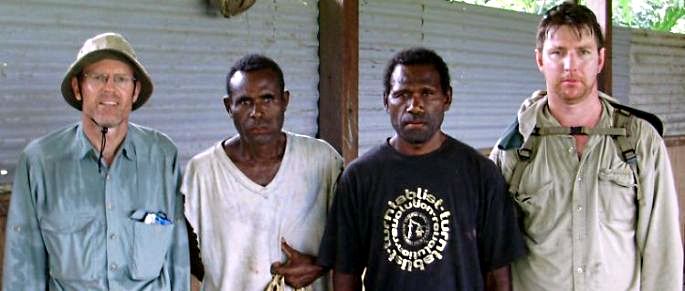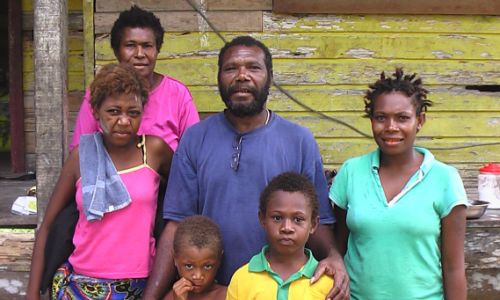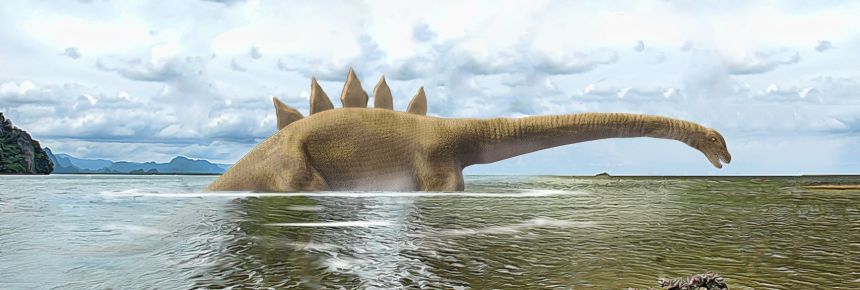
Article from
http://creation.com/more-dino-sightings-png
Published: 23 August 2012 (GMT+10)
Following on from his 2008 article Theropod and sauropod dinosaurs sighted in
PNG?, in January 2012 the author Brian Irwin
along with Russell Cook (both Australians) travelled to West New
Britain in Papua New
Guinea to investigate further reports of animals presumed to be extinct.
Here is an account of their conversations with eyewitnesses—local
people who claimed to have recently seen
dinosaur-like creatures.
|

Figure 1: The author,
Brian Irwin (left), with Russell Cook (right) at Gasmata, West New Britain, Papua New
Guinea, with locals Fabian Amon (second from left), and Matthew—local politician and interpreter (second from right).
Sauropod sightings in the south and north of West New Britain
1. Ambungi Island Sightings
The inhabitants of Ambungi Island
1
and the surrounding region have observed unusual animals that resemble
sauropod dinosaurs since
the mid-1990s. Ambungi Island is located about two kilometres south of
the south coast of West New Britain, approximately midway between
Kandrian and Gasmata. It is only since the 1920s that
Ambungi Island has been populated.
Swimming with a sauropod?
A local man named Alphones Likky (interviewed on 15
th January 2012—see
Figure 2) claimed to have seen a sauropod-like creature in 1995 while he was spearfishing on the
reef on the south side (unpopulated) of Ambungi Island.

Figure 2: While diving on a reef off
Ambungi Island in 1995, Alphones Likky (far left) was startled to see a
large sauropod-like creature about
five metres away.
Alphones was facing south at the bottom of the reef stalking fish
when, he says, he heard the sound of something crashing into the coral
behind him. When Alphones turned around he was
startled to see a large animal at close range, a distance of
approximately five metres (c. 15 feet), fully submersed in the water. He
says it moved slowly past from left to right and entered
the left of two underwater caves located on the south side of Ambungi
Island. (See
Figure 3.)

Figure 3: An artist’s reconstruction of the animal seen entering an underwater cave on the south
side of Ambungi Island.
Seeing the creature at such close range and being in the water with it, Alphones was terrified.
Alphones described the animal as having a long neck and tail and four
legs, with the hind legs being longer than the front legs and the feet
resembling those of a duck. The length of the
animal was estimated to be four metres from the front legs to the end of
the tail, with a height of two to three metres. The animal’s skin was
stated to be dark brown, the texture of
the skin could not be determined. The head of the creature was described
as being small and similar to a snake’s head; no teeth were observed
and the eye was described as being similar
to the eyes of other animals. Dermal frills were observed on the
animal’s back and tail, but not on the neck. The creature’s movement was
described as being slow, with the tail
moving noticeably. The neck of the creature was horizontal for the
duration of the sighting, which lasted about 10 seconds. Seeing the
creature at such close range and being in the water
with it, Alphones was terrified. Wanting to escape with his life from
this ordeal, Alphones promptly surfaced to reach his canoe and left the
area quickly. He certainly didn’t hang
around in hope of getting a glimpse of the creature’s body above the
water!

Figure 4—At the foot of the cliff on the south side of Ambungi Island near the two underwater
caves referred to in the main text. Above: Russell
Cook, donning the mask and snorkel, is preparing
to take a quick look at the cave entrances, and the nearby coral. Below:
As Mr Cook enters the water,
part of the entrance to the
left cave (the one the creature was seen entering) can be seen at right.
(These two photos guided the artist’s illustration of the background
landscape of
Figure 3.)

Figure 5: Alice Pasington (top left) tells of encountering a dinosaur in her garden.
The two underwater caves on the south side of Ambungi Island are
separated by a distance of approximately 20 metres. The left cave has a
circular entrance and has a height of about 2.5
metres. The right cave has a triangular entrance and also has a height
of about 2.5 metres and appears from the outside to be considerably
larger than the left cave. Neither cave has been
explored because of the unavailability of sophisticated diving and
lighting equipment.
A dinosaur in the garden?
In 1999 the second good sighting of one of these creatures occurred,
however on this occasion the animal was observed on the land.
Alice Pasington (interviewed on 14
th January 2012) was
working alone in the garden on the south side of the island when she
claims to have had an unusual encounter. From a
distance of about 40 metres, Alice observed one of the creatures and
estimated the total length to be about three metres. (See artist’s
reconstruction in
Figure 6.)

Figure 6: An artist’s reconstruction of
the three-metre animal that Alice Pasington says she saw
while working
in the garden about 40 metres away.

Figure 7: The actual plant with the rough-textured leaf that Alice Pasington saw the animal eating.
The colour of the animal’s skin was reddish-brown and white around
the breast area. The texture of the skin appeared smooth and dermal
frills were seen only on the tail. The animal
moved slowly with its neck nearly vertical and Alice saw it feeding on a
plant with a rough-textured leaf (see
Figure 7).
Alice then observed the animal turn around and walk to a small cliff,
where it dived into the sea. During this time, the creature was
followed at a distance and did not seem aware of
Alice’s presence. After the animal had left the garden, Alice observed
the five-toed footprints in the ground and later showed these footprints
to other residents of Ambungi Island.
The animal may have entered the garden from the beach on the western
side of the island during the night. From the above description, it is
possible that it may have been a juvenile specimen of the same type of
creature as the other sightings, based on its size, colour, footprint
and smooth skin texture.
Sleeping on a rock
Once the animal heard the sound of people, it moved from the rock back into the sea.
In 2007, Jasinta Pitim, another resident of Ambungi Island, observed
the profile of a large animal sleeping on a rock on a reef on the south
side of Ambungi Island. The animal was
described as having a long neck that was curved back near its body,
which was dark-brown, with skin described as being like a crocodile, and
with dermal frills. Jasinta hurried home and
told her husband Joe (interviewed on 14
th January 2012), who
travelled to the location, where he saw it too. Once the animal heard
the sound of people, it moved from the rock
back into the sea. Back in 1997 Joe and Jasinta observed a similar
animal while travelling from Ambungi Island to Malengo Island in a
canoe. From a distance of approximately eight metres
the head and neck of the creature were visible for a short period of
time.
Similar animals have also been observed on islands close to Ambungi Island.

Figure 8: Joe and Jasinta Pitim
observed a large aquatic animal sunning itself on a rock on a reef
off
Ambungi Island in 2007. They had seen the head and
neck of a similar creature protruding
above the sea while travelling by
canoe ten years earlier.
2. Gasmata sighting
A creature similar to the one(s) observed around Ambungi Island has
also been seen once near Gasmata. One afternoon in August 2004, three
adults—Fabian Amon (see
Figure 1), Simon
Patolkit
2 (
Figure 9) and Margaret Patolkit—along with some children observed a sauropod-like creature on the south side of
Dililo Island, an unpopulated island used mainly for farming by the local people from Gasmata.

Figure 9: The gentleman at the far left
of this photo is Simon Patolkit, who along with his wife
Margaret and
others observed a huge creature in the sea off
Gasmata. (See
Figure 10.)
Simon was interviewed on 13
th January 2012 at the location of the sighting and Fabian was interviewed on 18
th January 2012. Both of their accounts of the sighting
were very similar.
Simon, Margaret and Fabian were diving for fish on the reef on the
south side of Dililo Island when they heard an unusual sound in the
water and noticed that the fish were scattering.
They became somewhat frightened by this incident and left the water for
the safety of the land. A short time later, while sitting on some rocks,
they observed part of an unknown animal above
the water about 40–50 metres away and travelling in an east-west
direction parallel to the coast.
The creature had a large body and a neck estimated to be three metres
long that was horizontal and close to the water. No tail or legs were
visible and the total length of the visible
portion of the animal was about eight metres. The head was like a
crocodile or lizard and the eye was described as being ‘big’. The colour
of the animal was uniform brown and the
skin had a rough texture. The animal was described as having a ‘saw’ in
the middle of its back, which consisted of 4 or 5 dermal frills.
Observation time lasted about one minute
during which time the creature moved slowly until it submersed itself
fully in the water.

Figure 10: An artist’s reconstruction of
the creature observed at Gasmata Reef. It held its head and
neck (about
3 metres long) just above the water and
was described as having a ‘saw’ in the middle
of its back. The visible
part of the creature was estimated to be about 8 metres (26 feet) in
length—
but its total body length
was likely considerably greater, given its tail was submerged and out of
view.
3. Possible theropod sighting in the north of West New Britain
A small theropod-like creature that local people have dubbed ‘Doren’ has been repeatedly observed around Benaule Village
3,
which is located approximately 25 km east of Kimbe on the north coast of
West New Britain. The creature has been seen quite frequently for many
years, with a close encounter reported in
November 2010.

Figure 11: Pastor Ken-John showing the height of the ‘Doren’ he saw while using the toilet.
Pastor Ken-John was sitting on an ‘outhouse’ toilet at the Tabernacle
Of Worship church during the day when he observed the profile of the
head and upper torso of the
‘Doren’ appear only one metre away, just outside. The head was described
as being like that of an aircraft (presumably like the profile of the
nose of a jet, such as a 747) and
the colour was medium brown. The animal has also been seen on the
seashore near the church grounds by local people, where it comes ashore
during high tide and travels back to the sea during
low tide.

Figure 12: Pastor Ken-John stands by the
sea in the grounds of the Tabernacle of Worship church, showing where
he says the ‘Doren’ comes ashore
at high tide. With him are Ben (the landowner) and John.
The ‘Doren’ has been observed eating crabs and digging up vegetables from a garden.
A distinctive footprint of the ‘Doren’, which is described as being
about 25cm long, is often seen in the sand by the sea. The left foot of
the creature was drawn in the sand by
a local person (see
Figure 13).
During the wet season, the ‘Doren’ travels inland along a creek to a
mountain. The ‘Doren’ has been observed eating crabs and digging up
vegetables from a garden near the church—apparently looking for worms
and other invertebrates to eat, as it doesn’t normally eat the
vegetables it unearths.

Figure 13: The footprint of the ‘Doren’—as drawn in the sand by Ben (
Figure 12).

Figure 14: A scan of pages from the 2003 evolutionary dinosaur handbook by H. Richardson,
Dinosaurs and prehistoric life, showing a scientific
illustration of
Herrerasaurus (on the right-hand page).
Click for larger image.
When walking, the ‘Doren’ uses four legs. However, when
running the creature is reported as using
rear legs only and as being able to outrun a human. It seems
from the descriptions that the ‘Doren’ might be best identified as a
Herrerasaurus.
4
Concluding remarks
Reports alone are ultimately not enough to conclusively establish the
fact that some dinosaurs are still alive today. However, if these are
eventually backed up by hard evidence, the
finding of living dinosaurs should not be such a surprise to people,
considering that some animals and plants that were believed to be
extinct for millions of years have been discovered
alive. These discoveries include
the Coelacanth fish (discovered in 1938) and
the Wollemi
Pine tree (discovered in 1994). For Christians it should be less
surprising still, as the authority of the Bible is a solid basis for
believing that humans have lived at the same time
as dinosaurs (whether or not some dinosaurs still survive); because
Genesis teaches that the heavens, the earth, and everything in them was
created in that six-day period about 6000 years
ago. The remains of dinosaurs (some of which are still ‘
soft and squishy’, with identifiable proteins) would be no
older than the Genesis Flood, which occurred about 4,500 years ago.








 Back to Other biographies and interviews of interest
Back to Other biographies and interviews of interest
 Professor of Astronomy (United States)
Professor of Astronomy (United States) Back to Scientists alive today who accept the biblical account for creation
Back to Scientists alive today who accept the biblical account for creation























